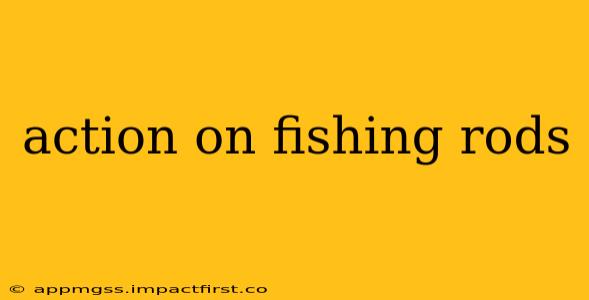Choosing the right fishing rod is crucial for a successful fishing trip. A key factor to consider is the rod's action, which significantly impacts your casting distance, sensitivity, and overall fishing experience. This guide will delve into the different types of rod actions, helping you understand which is best suited for your needs.
What is Rod Action?
Rod action refers to the way a rod bends under pressure. It's described as the flex pattern from the tip to the butt of the rod when a fish is hooked or a lure is cast. Understanding rod action is vital because it directly influences how you feel the fish, how you cast, and the type of fishing you can effectively do. Different actions are better suited for different fishing styles and target species.
Types of Rod Action: A Detailed Breakdown
Rod actions are generally categorized into several types, with variations within each category. Here's a breakdown of the common types:
1. Extra-Fast Action:
- Characteristics: Bends only in the top third of the rod. This action offers powerful hooksets and long casting distances.
- Best For: Throwing lightweight lures, jigs, and accurately placing baits at long distances. Ideal for species that require quick, precise hooksets.
- Example: Excellent for targeting bass with small crankbaits or spinnerbaits.
2. Fast Action:
- Characteristics: Bends in the top half of the rod. This action provides a good balance of power and sensitivity.
- Best For: A wide variety of fishing techniques, from casting lures to jigging and flipping. It's a versatile choice for many anglers.
- Example: Suitable for targeting a range of species, including trout, bass, and walleye, using various techniques.
3. Moderate-Fast Action:
- Characteristics: Bends roughly in the middle two-thirds of the rod. Offers a good blend of power, sensitivity, and forgiveness.
- Best For: Versatile applications, including casting, jigging, and trolling. Forgiving enough for beginners, but powerful enough for handling larger fish.
- Example: A popular choice for all-around fishing, encompassing various species and techniques.
4. Moderate Action:
- Characteristics: Bends in the lower two-thirds of the rod. Provides a softer feel and absorbs shock well, protecting lighter line.
- Best For: Fishing with lighter lines, protecting delicate tackle, and fighting larger fish with more give. Offers good sensitivity.
- Example: Well-suited for finesse fishing techniques or targeting larger, more powerful fish where a softer rod can prevent line breakage.
5. Slow Action:
- Characteristics: Bends almost the entire length of the rod. Provides a very soft feel and exceptional sensitivity.
- Best For: Finesse techniques, such as fishing with live bait or light lures, where detecting subtle bites is critical.
- Example: Ideal for catching panfish or other delicate fish species.
How to Determine Rod Action?
While rod manufacturers provide action descriptions, the best way to assess action is by physically flexing the rod. Gently bend the rod and observe the flex pattern. You should feel the bend and notice where it's most pronounced.
What is the difference between rod action and power?
Often confused, rod action and power are distinct features:
- Action describes how the rod bends.
- Power describes how much the rod bends under pressure. A powerful rod will bend less than a lighter power rod under the same load.
Understanding both is crucial for selecting the right rod for your fishing style.
What kind of rod action is best for beginners?
For beginners, a moderate-fast action rod is generally recommended. This provides a good balance between power, sensitivity, and forgiveness, making it easier to learn casting and handling fish.
How does rod action affect casting distance?
Faster action rods generally offer greater casting distance due to their stiffer tips, allowing for more efficient energy transfer to the lure. However, slower action rods can also cast well with the right technique.
Conclusion
Choosing the right rod action is paramount for an enjoyable and successful fishing experience. By understanding the different types of actions and their characteristics, you can select the ideal rod for your specific needs, target species, and fishing techniques. Remember to consider both the rod's action and power to ensure a perfect match for your fishing style.
